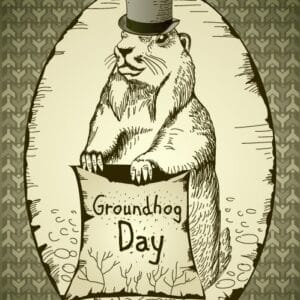Groundhog Day is an American tradition from 1887 during The Gilded Age (1870s – 1900). The superstitious observance began in Punxsutawney, Pennsylvania – where Punxsutawney Phil got his name and started as a rodent meteorologist. Each year on Feb. 2, thousands of spectators travel to the small town and gather at Gobbler’s Knob Park to view Punxsutawney Phil’s prediction in real-time.
This tradition stems from the Christian holiday of Candlemas, when clergy would bless and distribute candles for winter. The candles represented how long and cold the winter would be. The Candlemas tradition originated in Europe, where Germans began selecting an animal to predict the weather. At first, hedgehogs were used, but when Germans immigrated to Pennsylvania, they switched to local groundhogs. The first recorded Groundhog Day in the U.S. happened in 1840 in Morgantown, Pennsylvania. The holiday gained widespread fame after a newspaper editor promoted the Punxsutawney festivities in 1887.
Famous Groundhogs & Groundhog Day Predictions
If Punxsutawney Phil sees his shadow at daybreak and runs away, tradition dictates that he’s predicted that there will be six more weeks of winter. He’s predicted that spring will arrive early if there’s no shadow.
While Punxsutawney Phil gets most of the national attention, other weather-predicting groundhogs across North America exist. Some of the more famous ones include Staten Island Chuck in New York, General Beauregard Lee in Georgia, and Wiarton Willie in Canada. Phil even has some female competition from Pennsylvania groundhogs like Mathilda in Easton and Gen. Pershing in Westmoreland County.
In recent years, Phil’s predictions have been called into question. According to records kept by the Punxsutawney Groundhog Club, Phil has seen his shadow about 85% of the time, signalling more winter ahead. However, an analysis of weather data over the same period found that Phil’s predictions were only correct 39% of the time.
The Cultural Significance of Groundhog Day
Regardless of Phil’s questionable forecasting record, Groundhog Day is a popular folk holiday in the United States and Canada. From coverage by national news outlets to crazy costumes and crowds numbering in the thousands in Punxsutawney, it’s clear that people still find meaning and fun in the tradition.
The lighthearted nature of Groundhog Day is a perfect antidote to the winter blues, giving people an excuse to celebrate midway through the long cold season. While Phil may not be as accurate as modern meteorology, Groundhog Day is a beloved cultural event. Americans eagerly await the eccentric groundhog’s prediction each February 2nd, as they have for over 130 years.
Though meteorologists caution against relying on a groundhog for accurate forecasts, the holiday persists because of its entertainment value and ability to boost morale during dreary winter months.
Groundhog Day Food and Menu Ideas
 Since Groundhog Day often falls around the same time as the Super Bowl, foods like wings, pizza, and nachos are popular menu items. Hearty comfort foods like soups, chilli, and potato dishes are also welcomed on a cold February day.
Since Groundhog Day often falls around the same time as the Super Bowl, foods like wings, pizza, and nachos are popular menu items. Hearty comfort foods like soups, chilli, and potato dishes are also welcomed on a cold February day.
For breakfast, pancakes and sausages are a natural choice to celebrate a famous prognosticating rodent.








